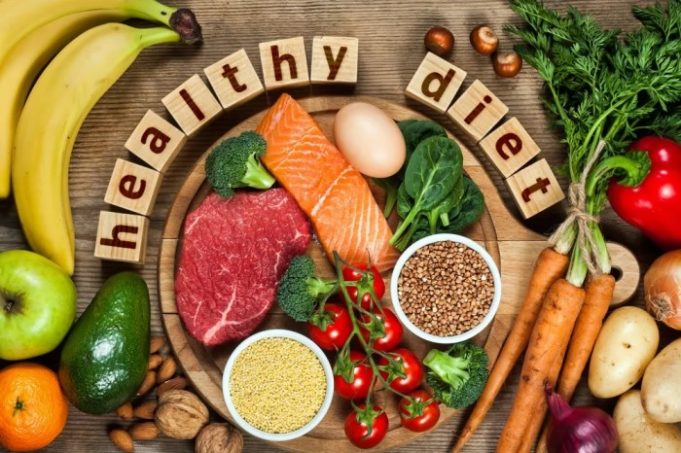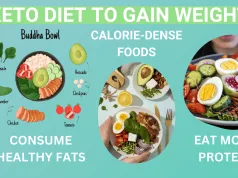How to improve diet – How to improve your diet is a question many ask, seeking a path to better health and well-being. This journey begins with understanding your current eating habits and identifying areas for improvement. It’s not about drastic changes, but about making small, sustainable choices that nourish your body and mind.
This guide will equip you with the knowledge and tools to create a balanced, nutrient-rich diet that aligns with your individual needs and preferences. We’ll explore setting realistic goals, incorporating essential nutrients, managing portion sizes, and staying hydrated. We’ll also discuss the importance of physical activity and the benefits of seeking professional guidance when needed.
Understanding Your Current Diet
Before you can improve your diet, you need to understand what you’re currently eating. This involves taking a close look at your typical daily food intake and identifying any potential nutritional deficiencies or excesses.
Identifying Potential Nutritional Deficiencies and Excesses
It’s important to assess your current diet for any nutritional imbalances. This can involve analyzing your typical daily food intake and comparing it to recommended dietary guidelines.
For instance, if you regularly consume processed foods, sugary drinks, and fast food, you might be deficient in essential nutrients like fiber, vitamins, and minerals. On the other hand, consuming excessive amounts of saturated and trans fats, added sugars, and sodium can contribute to health issues like weight gain, heart disease, and type 2 diabetes.
Identifying Foods or Food Groups Contributing to Health Issues
Certain foods or food groups can contribute to health problems if consumed in excess. These include:
- Processed Foods: Processed foods are often high in unhealthy fats, added sugars, sodium, and artificial ingredients. These can contribute to weight gain, heart disease, and other chronic health conditions.
- Sugary Drinks: Sugary drinks like soda, juice, and energy drinks provide empty calories and can lead to weight gain, tooth decay, and type 2 diabetes.
- Fast Food: Fast food is often high in calories, saturated fat, sodium, and unhealthy ingredients. It can contribute to weight gain, heart disease, and other health problems.
- Red Meat: Consuming large amounts of red meat can increase the risk of heart disease, certain types of cancer, and other health problems.
- Saturated and Trans Fats: These unhealthy fats are found in processed foods, fast food, and some animal products. They can increase the risk of heart disease and other health problems.
- Added Sugars: Added sugars are found in processed foods, sugary drinks, and many desserts. They can contribute to weight gain, tooth decay, and other health problems.
- Sodium: Excessive sodium intake can lead to high blood pressure, which increases the risk of heart disease and stroke.
It’s important to note that these are just general examples, and the specific foods or food groups that contribute to health issues can vary depending on individual factors such as age, gender, health conditions, and lifestyle.
Setting Realistic Goals
Making significant dietary changes can be challenging, so setting realistic goals is crucial for long-term success. Instead of aiming for drastic overhauls, focus on making gradual, sustainable changes that fit your lifestyle and preferences.
Setting SMART Goals
SMART goals are specific, measurable, achievable, relevant, and time-bound. They provide a clear framework for tracking progress and staying motivated.
- Specific: Clearly define what you want to achieve. For example, instead of saying “eat healthier,” specify “increase fruit and vegetable intake to five servings per day.”
- Measurable: Quantify your goals to track progress. For instance, instead of “drink more water,” aim for “drinking eight glasses of water daily.”
- Achievable: Set goals that are challenging but attainable. If you currently eat fast food five times a week, aiming for one healthy meal a day is a more realistic starting point than eliminating all fast food.
- Relevant: Ensure your goals align with your personal needs and preferences. If you dislike vegetables, focus on incorporating other healthy foods you enjoy.
- Time-bound: Set a deadline for achieving your goals. This helps create a sense of urgency and encourages action. For example, “reduce sugar intake by 50% within three months.”
Importance of Gradual Changes
- Avoid Overwhelm: Drastic dietary restrictions can lead to feelings of deprivation and make it difficult to sustain changes. Gradual adjustments allow your body and mind to adapt gradually.
- Long-Term Sustainability: Small, sustainable changes are more likely to become lifelong habits than extreme diets that are difficult to maintain.
- Reduced Risk of Nutrient Deficiencies: Sudden changes can disrupt nutrient intake. Gradual adjustments allow your body to adjust and maintain essential nutrient levels.
Incorporating Nutrient-Rich Foods
It’s not just about eating less; it’s about eating the right foods. By focusing on nutrient-rich foods, you can nourish your body and improve your overall health. These foods are packed with vitamins, minerals, and fiber, which are essential for maintaining energy levels, supporting immune function, and promoting healthy digestion.
Essential Nutrients and Their Food Sources
A balanced diet should include a variety of foods from all food groups to ensure you’re getting all the essential nutrients your body needs. Here’s a table that Artikels some key nutrients and their corresponding food sources:
| Nutrient | Food Group | Food Sources |
|---|---|---|
| Vitamin C | Fruits and Vegetables | Citrus fruits (oranges, grapefruits), strawberries, bell peppers, broccoli |
| Vitamin A | Fruits and Vegetables | Sweet potatoes, carrots, spinach, kale, cantaloupe |
| Iron | Meat and Beans | Red meat, beans, lentils, spinach, fortified cereals |
| Calcium | Dairy and Leafy Greens | Milk, yogurt, cheese, leafy green vegetables (kale, spinach) |
| Fiber | Fruits, Vegetables, and Whole Grains | Fruits, vegetables, whole grains (brown rice, quinoa, oats), beans, lentils |
| Protein | Meat, Beans, and Nuts | Meat, poultry, fish, eggs, beans, lentils, nuts, seeds |
Nutrient-Rich Recipes and Meal Plans
Here are some examples of recipes and meal plans that prioritize nutrient-rich ingredients:
Breakfast:
– Oatmeal with berries and nuts: A hearty and nutritious breakfast option that provides fiber, protein, and antioxidants.
– Smoothie with spinach, banana, and Greek yogurt: A quick and easy way to get your daily dose of fruits, vegetables, and protein.
Lunch:
– Salad with grilled chicken or fish, mixed greens, and a variety of vegetables: A light and refreshing lunch option that is packed with nutrients.
– Lentil soup with whole-wheat bread: A hearty and filling lunch that is high in fiber and protein.
Dinner:
– Salmon with roasted vegetables: A healthy and flavorful dinner option that provides omega-3 fatty acids and antioxidants.
– Chicken stir-fry with brown rice: A quick and easy dinner that is packed with protein, fiber, and vegetables.
Benefits of Incorporating a Variety of Foods
Incorporating a variety of fruits, vegetables, whole grains, and lean proteins into your diet offers numerous benefits:
– Improved Energy Levels: Nutrient-rich foods provide sustained energy throughout the day, helping you feel more alert and focused.
– Boosted Immune System: Vitamins and minerals found in these foods support a strong immune system, reducing the risk of illness.
– Enhanced Digestion: Fiber from fruits, vegetables, and whole grains promotes healthy digestion and regularity.
– Reduced Risk of Chronic Diseases: A balanced diet rich in nutrients can help lower the risk of developing chronic diseases such as heart disease, stroke, type 2 diabetes, and certain types of cancer.
– Improved Mental Health: Some nutrients, such as omega-3 fatty acids, are linked to improved mood and cognitive function.
Managing Portions and Calories
Portion control is a crucial aspect of healthy eating. It involves consuming the right amount of food to meet your body’s needs without overeating. By managing portions, you can prevent calorie surplus, which can lead to weight gain and other health issues.
Estimating Serving Sizes
Accurately estimating serving sizes is essential for portion control. Here are some tips to help you:
- Use measuring cups and spoons: This is the most accurate way to measure portions.
- Read food labels: Food labels provide information on serving sizes and calories per serving.
- Use your hand as a guide: For protein, a palm-sized portion is about 3-4 ounces. For carbohydrates, a fist-sized portion is about 1/2 cup.
Understanding Calorie Needs
Calorie needs vary based on factors such as age, gender, activity level, and weight goals.
- Use online calculators: Numerous online calculators can help estimate your daily calorie needs based on your individual factors.
- Consult a registered dietitian: A registered dietitian can provide personalized recommendations for your calorie needs.
- Track your calorie intake: Use a food journal, app, or online tracker to monitor your daily calorie intake.
Tracking Food Intake
Tracking your food intake is a valuable tool for portion control and calorie management.
- Food Journal: A traditional food journal involves manually recording all the foods you eat throughout the day, along with their portion sizes.
- Food Tracking Apps: Many mobile apps are available that allow you to track your food intake by searching for foods in their databases or scanning barcodes. These apps often provide calorie and macronutrient information and can help you monitor your progress.
- Online Food Diaries: Some websites offer online food diaries where you can log your meals and track your calorie intake.
Hydration and Its Importance: How To Improve Diet
Water is essential for life and plays a crucial role in maintaining overall health and well-being. It’s involved in numerous bodily functions, from regulating temperature to transporting nutrients and flushing out waste products.
The Role of Water in Maintaining Overall Health
Adequate hydration is crucial for various bodily functions. Water helps regulate body temperature, transports nutrients and oxygen to cells, lubricates joints, and flushes out waste products. It also plays a vital role in maintaining electrolyte balance, which is essential for nerve and muscle function.
Daily Water Intake Recommendations
The amount of water you need to drink each day varies based on individual factors such as age, activity level, climate, and overall health. Here are some general guidelines:
The National Academies of Sciences, Engineering, and Medicine recommends that men consume about 15.5 cups (3.7 liters) of fluids per day and women consume about 11.5 cups (2.7 liters) of fluids per day.
However, these recommendations can vary based on individual needs. It’s essential to listen to your body and drink water when you feel thirsty.
Incorporating Other Hydrating Beverages
While water is the most important source of hydration, other beverages can also contribute to your daily fluid intake. Herbal teas, for example, can be a healthy and refreshing alternative to sugary drinks. Some popular herbal teas include:
- Chamomile tea: known for its calming effects and potential to aid sleep.
- Ginger tea: may help soothe nausea and aid digestion.
- Peppermint tea: often used to relieve indigestion and bloating.
It’s important to note that some herbal teas may contain caffeine, so it’s best to choose decaffeinated options if you’re trying to limit your caffeine intake.
Making Healthy Choices When Eating Out
Eating out can be a social experience and a convenient way to enjoy a meal. However, it can also be challenging to make healthy choices when faced with tempting options and large portions. Fortunately, there are strategies you can employ to navigate restaurant menus and make informed decisions that align with your dietary goals.
Navigating Restaurant Menus
Making healthy choices when eating out begins with understanding the menu. Restaurants often use descriptive language to make dishes sound appealing, but it’s important to look beyond the marketing and focus on the ingredients.
- Read the Menu Carefully: Pay attention to the ingredients listed, especially if you have allergies or dietary restrictions. Look for dishes that are grilled, baked, or steamed, as these methods typically use less fat and calories than frying.
- Ask Questions: Don’t hesitate to ask your server about the preparation methods, ingredients, and portion sizes. If you have specific dietary needs, inform the server so they can guide you to appropriate options.
- Choose Smaller Portions: If you’re concerned about overeating, opt for a smaller portion or split a dish with a friend. Many restaurants offer smaller plates or “light” options.
- Start with a Salad: Salads can be a healthy and filling way to start your meal. Choose a salad with a light dressing and avoid toppings that are high in calories and fat, such as cheese, croutons, and bacon.
Making Healthy Substitutions
Restaurants are often willing to accommodate dietary needs and preferences. Don’t be afraid to ask for substitutions or modifications to make dishes healthier.
- Swap Sides: Instead of fries or mashed potatoes, ask for a side of vegetables, brown rice, or quinoa.
- Request Sauce on the Side: Many sauces are high in calories and fat. Requesting your sauce on the side allows you to control how much you use.
- Skip the Bread Basket: Bread baskets can be tempting, but they are often high in calories and can make you feel full before your meal.
Identifying Hidden Ingredients
Restaurant meals can contain hidden ingredients that can sabotage your healthy eating efforts.
- Watch for Added Sugar: Many dishes, even those that seem healthy, can contain added sugar in sauces, marinades, and dressings. Look for dishes that are labeled “sugar-free” or “low-sugar.”
- Be Aware of Hidden Fats: Fried foods, creamy sauces, and rich desserts are often high in unhealthy fats. Choose grilled or baked options and request that sauces be made with low-fat ingredients.
- Check for Sodium: High sodium intake can contribute to high blood pressure. Look for dishes that are labeled “low-sodium” or ask the restaurant if they can prepare dishes with less salt.
The Role of Physical Activity

Physical activity is an essential component of a healthy lifestyle, working in synergy with a balanced diet to achieve optimal well-being. Regular exercise complements a nutritious diet by boosting metabolism, enhancing nutrient absorption, and promoting overall physical and mental health.
Benefits of Physical Activity, How to improve diet
Regular exercise, when combined with a balanced diet, offers a multitude of benefits for overall health.
- Improved Cardiovascular Health: Physical activity strengthens the heart and improves blood circulation, reducing the risk of heart disease, stroke, and high blood pressure.
- Weight Management: Exercise burns calories, helping to maintain a healthy weight or promote weight loss, reducing the risk of obesity-related health problems.
- Enhanced Mood and Cognitive Function: Physical activity releases endorphins, which have mood-boosting effects, and improves cognitive function, reducing the risk of depression and anxiety.
- Stronger Bones and Muscles: Exercise strengthens bones and muscles, reducing the risk of osteoporosis and improving balance and coordination.
- Improved Sleep Quality: Regular physical activity promotes better sleep quality, reducing the risk of insomnia and other sleep disorders.
Moderate-Intensity Physical Activities
Moderate-intensity physical activities are ideal for incorporating into a healthy lifestyle. These activities elevate your heart rate and breathing, but you should still be able to hold a conversation while engaging in them. Examples include:
- Brisk Walking: A 30-minute brisk walk most days of the week can provide significant health benefits.
- Cycling: Cycling at a moderate pace for 30 minutes or more can improve cardiovascular health and strengthen leg muscles.
- Swimming: Swimming is a low-impact exercise that provides a full-body workout and is suitable for people of all fitness levels.
- Dancing: Dancing is a fun and enjoyable way to get exercise, improving cardiovascular health and coordination.
- Gardening: Gardening involves physical activity, such as digging, planting, and weeding, which can be beneficial for overall health.
Enhanced Nutrient Absorption and Metabolism
Regular exercise plays a crucial role in enhancing nutrient absorption and improving metabolism.
- Increased Blood Flow: Exercise increases blood flow to muscles and organs, facilitating the delivery of nutrients and oxygen to cells.
- Improved Insulin Sensitivity: Regular physical activity enhances insulin sensitivity, enabling the body to utilize glucose more effectively, reducing the risk of type 2 diabetes.
- Boosted Metabolism: Exercise increases metabolism, helping the body burn calories more efficiently, even at rest.
Seeking Professional Guidance
Navigating the world of nutrition can be overwhelming, especially when trying to make personalized changes. Consulting a registered dietitian or nutritionist can provide invaluable support and guidance on your journey to a healthier diet.
Benefits of Professional Guidance
Seeking professional guidance from a registered dietitian or nutritionist offers numerous benefits, empowering you to make informed decisions about your dietary choices.
- Personalized Dietary Plans: A professional can create a customized meal plan tailored to your individual needs, goals, and preferences, considering factors such as your age, activity level, health conditions, and dietary restrictions.
- Addressing Specific Dietary Concerns: A registered dietitian can help you address specific dietary concerns or medical conditions, such as diabetes, heart disease, or food allergies. They can provide evidence-based recommendations and strategies to manage these conditions through diet.
- Overcoming Challenges: With their expertise, dietitians can help you overcome challenges related to your diet, such as cravings, emotional eating, or difficulty sticking to a meal plan. They can provide practical strategies and support to help you stay on track.
- Building Healthy Habits: A registered dietitian can educate you about healthy eating habits and help you develop a sustainable approach to nutrition that promotes long-term well-being.
- Weight Management: If you’re aiming for weight loss or maintenance, a dietitian can help you create a balanced and sustainable diet plan that supports your goals.
The Role of a Healthcare Professional
A registered dietitian plays a crucial role in addressing specific dietary concerns or medical conditions. They can:
- Assess Your Nutritional Status: They will evaluate your current dietary intake, medical history, and any existing health conditions to determine your nutritional needs and potential deficiencies.
- Provide Evidence-Based Recommendations: They offer recommendations based on scientific evidence and current dietary guidelines, ensuring that your dietary plan is safe and effective.
- Monitor Progress and Make Adjustments: They will monitor your progress and make adjustments to your meal plan as needed, ensuring that you’re on track to achieve your goals.
- Address Specific Concerns: They can provide guidance on managing specific health conditions through diet, such as diabetes, heart disease, or high cholesterol.
- Collaborate with Other Healthcare Professionals: They work collaboratively with other healthcare professionals, such as doctors and pharmacists, to ensure that your dietary plan aligns with your overall health care plan.
Dietary Restrictions and Allergies
It’s essential to consider individual dietary restrictions or allergies when making dietary changes.
- Food Allergies: If you have a food allergy, it’s crucial to avoid the offending food to prevent allergic reactions. A registered dietitian can help you identify safe substitutes and create a meal plan that meets your needs.
- Food Intolerances: Food intolerances can cause digestive discomfort but are not life-threatening. A dietitian can help you identify foods that trigger your symptoms and develop a plan to manage them.
- Religious or Cultural Dietary Restrictions: Some religions or cultures have specific dietary restrictions. A dietitian can help you find healthy and delicious options that align with your beliefs and traditions.
- Personal Preferences: Everyone has different preferences, and a dietitian can help you incorporate your favorite foods into a healthy diet plan.
Closing Notes
Improving your diet is a journey, not a destination. It’s about making informed choices that support your overall health and well-being. By understanding your current eating habits, setting realistic goals, and incorporating healthy practices, you can create a sustainable and enjoyable dietary pattern that fuels your body and mind. Remember, small changes can lead to big results, so embrace the journey and celebrate your progress along the way.
Frequently Asked Questions
What are some easy ways to improve my diet?
Start by adding more fruits, vegetables, and whole grains to your meals. Choose lean protein sources and limit processed foods, sugary drinks, and unhealthy fats.
How can I make sure I’m getting enough nutrients?
Focus on a variety of foods from all food groups. Consult a registered dietitian or nutritionist for personalized guidance.
What are some healthy snack options?
Opt for fruits, vegetables, nuts, seeds, yogurt, or hard-boiled eggs. Avoid processed snacks and sugary treats.
Is it okay to eat out sometimes?
Yes, but make healthy choices when eating out. Choose grilled or baked options, request substitutions, and be mindful of portion sizes.
Improving your diet often involves making small, sustainable changes. One of these might be cutting back on artificial sweeteners, which can actually lead to cravings for more sugary foods. If you’re a Diet Coke fan, you might want to check out how to quit diet coke for some tips.
By focusing on whole foods and natural sugars, you’ll be on your way to a healthier and more balanced diet.
Making positive changes to your diet can be a great way to improve your overall health. If you’re looking to manage fatty liver, you might wonder if a ketogenic diet could be beneficial. Is keto diet good for fatty liver ?
It’s important to consult with a healthcare professional to determine the best dietary approach for your individual needs and to ensure it aligns with your overall health goals.
Improving your diet is a journey, not a destination. It’s about making gradual changes that fit your lifestyle. If you’re wondering about how alcohol fits into your diet, you might find this article helpful: what diet can you drink alcohol.
Remember, moderation is key, and it’s always a good idea to consult with a healthcare professional for personalized advice.
























